The robot controller, integrator, and software market is growing steadily due to rising automation demand across manufacturing, logistics, and service industries. Increasing labor costs and the need for higher production efficiency have driven manufacturers to adopt advanced robotic systems integrated with intelligent control software.
The market’s growth is further propelled by advancements in artificial intelligence, IoT connectivity, and cloud-based monitoring platforms, which enable predictive maintenance and real-time process optimization. Integration services are becoming vital as industries seek customized robotic solutions tailored to complex workflows.
The current landscape reflects strong adoption in automotive, electronics, and metalworking industries, with rapid expansion expected in e-commerce and healthcare sectors. With ongoing industrial digitalization and government incentives supporting smart manufacturing, the market outlook remains optimistic, emphasizing interoperability, precision, and enhanced data analytics capabilities.
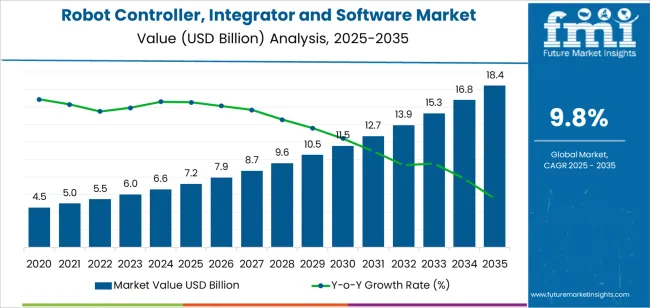
| Metric | Value |
|---|---|
| Robot Controller, Integrator and Software Market Estimated Value in (2025 E) | USD 7.2 billion |
| Robot Controller, Integrator and Software Market Forecast Value in (2035 F) | USD 18.4 billion |
| Forecast CAGR (2025 to 2035) | 9.8% |
The market is segmented by Type, Robot Type, and Industry Verticle and region. By Type, the market is divided into Controller, Integrator, and Software. In terms of Robot Type, the market is classified into Industrial Robots and Service Robots. Based on Industry Verticle, the market is segmented into Automotive, E-Commerce & Logistics, Metal & Machinery, Healthcare, Electrical & Electronic, Food & Beverage, Plastic & Chemical, and Other Industries. Regionally, the market is classified into North America, Latin America, Western Europe, Eastern Europe, Balkan & Baltic Countries, Russia & Belarus, Central Asia, East Asia, South Asia & Pacific, and the Middle East & Africa.
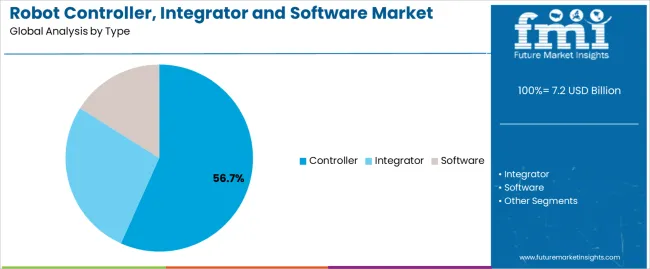
The controller segment dominates the type category with approximately 56.7% share, driven by its critical role in managing robot motion, speed, and coordination. The increasing complexity of automation tasks has elevated the importance of robust and flexible controllers capable of handling multi-axis synchronization and adaptive control.
Manufacturers prefer programmable and modular controllers for scalability and integration with factory networks. Advancements in sensor fusion and AI-assisted algorithms have improved performance accuracy and responsiveness.
The segment’s dominance is also reinforced by continuous hardware and firmware upgrades enhancing compatibility with diverse robot models. As industries move toward fully connected production environments, the demand for intelligent controllers enabling seamless human-robot collaboration is expected to sustain segment leadership.
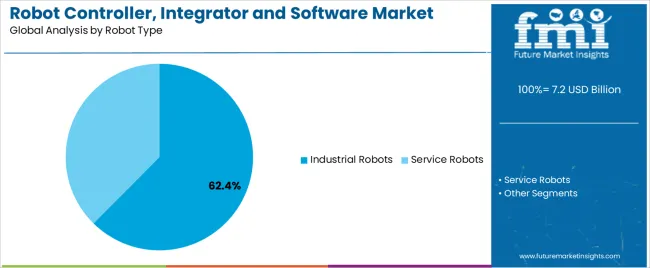
The industrial robots segment accounts for approximately 62.4% share of the robot type category, reflecting its long-standing dominance in manufacturing automation. High precision, operational speed, and repeatability have solidified their adoption in assembly, welding, material handling, and inspection processes.
The segment benefits from ongoing industrial modernization and the push toward Industry 4.0, which promotes integrated robotic ecosystems. Increased deployment in small and medium enterprises due to declining robot costs has further expanded its reach.
The integration of machine vision and advanced sensors enhances adaptability to variable production lines. With growing adoption across automotive, electronics, and metal industries, industrial robots are projected to maintain their majority share through the forecast period.
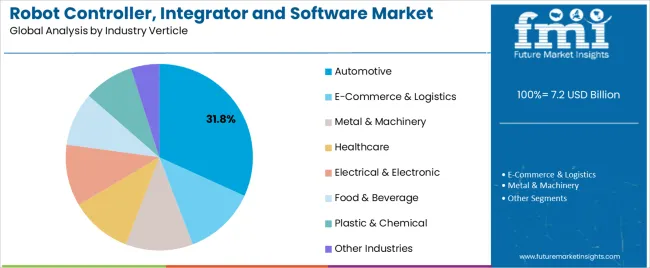
The automotive segment leads the industry vertical category with approximately 31.8% share, underpinned by the sector’s continuous pursuit of efficiency, precision, and scalability. The integration of robotic systems in welding, painting, and assembly lines has become standard practice, ensuring consistency and high throughput.
Automation demand is reinforced by electric vehicle production, which requires flexible and reconfigurable robotic systems to handle diverse components. Robotics integration also supports quality inspection and material handling operations, optimizing productivity.
The automotive industry’s early adoption of smart manufacturing technologies, combined with heavy investment in automation infrastructure, ensures that it remains the largest end-user of robot controllers and software solutions in the foreseeable future.
The robot controller, integrator, and software market was valued at USD 4.5 billion in 2020. The demand for robot controllers, integrators, and software increased at an astounding rate of 16.4.5% between 2020 and 2025.5. By the end of 2025.5, the overall market value was around USD 5.5 billion.
Many industries shifted toward remotely operated manufacturing facilities during the pandemic period. This has resulted in higher adoption of industrial robot controllers and control systems.
This fundamental change across most industrial economies is expected to strengthen the robot control technology and market outlook further during the forecast period.
| Attributes | Details |
|---|---|
| Robot Controller, Integrator, and Software Market Value (2020) | USD 4.5 billion |
| Market Revenue (2025.5) | USD 5.5 billion |
| Market Historical Growth Rate (CAGR 2020 to 2025.5) | 16.4.5% CAGR |
Miniaturized robot control systems that process signals for small robots by utilizing microfluidic channels constitute an emerging technology in robot control. For instance, the exoskeleton from Ekso Bionics is gaining traction these days.
Artificial intelligence-driven controllers are anticipated to play a significant role in shaping the future of robot integration. These controllers improve robot autonomy by learning from experience and adapting to changing contexts.
For example, OpenAI's robotic hand, Dactyl, learns and trains itself to manipulate items like humans. The company employs the same reinforcement learning technology that powers OpenAI Five to train the neural networks solely through simulation.
The table below lists CAGRs for five leading countries that are expected to witness higher growth rates when it comes to the adoption of robot controllers, integrators, and software solutions.
| Regional Market Comparison | CAGR (2025 to 2035) |
|---|---|
| United States | 14.9% |
| Japan | 16% |
| United Kingdom | 16.1% |
| South Korea | 15.4% |
| China | 15.2% |
The United States robot controller, integrator, and software market is forecasted to advance at a CAGR of 14.9% per year between 2025 and 2035. The market value in the United States is forecasted to reach USD 18.4 billion by 2035.
The regional market for robot controllers, integrators, and software in the United Kingdom is expected to rise at a 16.1% CAGR through 2035. The market value in this country is anticipated to reach the USD 1 billion mark by 2035.
Robot controller, integrator, and software market players in China are likely to witness a remarkable growth rate of 15.2% from 2025 to 2035. The net worth of the market in China is projected to be USD 3.9 billion by 2035.
Robot controllers, integrators, and software development in Japan are expected to continue at a pace of 16% per year through the projected time period. By the end of this projected period, the total valuation of the market in Japan is likely to reach USD 2.7 billion.
The robot system controller, integrator, and software market in South Korea is expected to progress with a CAGR of 15.4% over the next ten years. All robotics industries in South Korea operating in these three sectors are expected to reach a combined valuation of USD 1.3 billion by 2035.
Based on type, the robot controller market trends seem promising for establishing it as the leading segment. The controller segment is expected to continue developing at a 14.7% CAGR throughout the forecasted period.
| Attributes | Details |
|---|---|
| Top Type Segment | Controller |
| Market Segment Growth Rate from 2025 to 2035 | 14.7% CAGR |
| Market Segment Growth Rate from 2020 to 2025 | 16.2% CAGR |
Based on robot type, the higher adoption of integration and control systems for industrial robots makes it the dominant segment. This segment is poised to expand further, with a CAGR of 14.5% over the next ten years.
| Attributes | Details |
|---|---|
| Top Robot Type or segment | Industrial Robot |
| Market Segment Growth Rate from 2025 to 2035 | 14.5% CAGR |
| Market Segment Growth Rate from 2020 to 2025 | 16% CAGR |
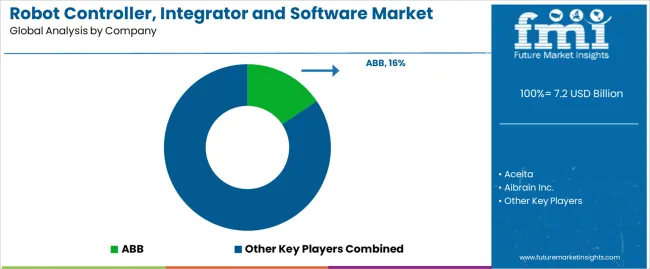
A trend toward greater customization in the robot software market is fostering the emergence of regional robot integrators and software developers. Their share in the robot controller market and robot integrator market is also anticipated to rise rapidly through 2035. This is because they offer specialized solutions that address particular industrial demands.
Recent Developments in the Robot Controller, Integrator, and Software Market
In May 2025, Alphabet's Intrinsic released a new robotic app development platform called Flowstate. Since 2024, a team has been investigating ways to enable industrial robots to perceive, learn, and autonomously adapt while performing tasks, allowing them to operate in a greater variety of environments and applications.
They were also testing robot control software that makes use of automated perception, deep learning, reinforcement learning, motion planning, simulation, and force control. Intrinsic claims that Flowstate is intended to fulfill some of those promises, besides assisting non-roboticists in creating processes for various hardware devices.
In November 2025, Realtime Robotics, the industry leader in collision-free autonomous motion planning for industrial robots, unveiled a new Optimization-as-a-Service solution.
This solution increases users' total efficiency by combining specialized robotics and application engineering knowledge with proprietary optimization tools.
| Attribute | Details |
|---|---|
| Estimated Market Size (2025) | USD 6.3 billion |
| Projected Market Size (2035) | USD 25 billion |
| Anticipated Growth Rate (2025 to 2035) | 14.8% CAGR |
| Forecast Period | 2025 to 2035 |
| Historical Data Available for | 2020 to 2025 |
| Market Analysis | USD million or billion for Value and Units for Volume |
| Key Regions Covered | North America; Latin America; Europe; Middle East & Africa (MEA); East Asia; South Asia and Oceania |
| Key Countries Covered | United States, Canada, Brazil, Mexico, Germany, Spain, Italy, France, United Kingdom, Russia, China, India, Australia & New Zealand, GCC Countries, and South Africa |
| Key Segments Covered | By Type, By Robot Type, By Industry Vertical, and By Region |
| Key Companies Profiled | ABB Group; Aibrain Inc.; Amtec Solutions Group; Artiminds Robotics GmbH |
| Report Coverage | Market Forecast, Company Share Analysis, Competition Intelligence, DROT Analysis, Market Dynamics and Challenges, and Strategic Growth Initiatives |
| Customization & Pricing | Available upon Request |
The global robot controller, integrator and software market is estimated to be valued at USD 7.2 billion in 2025.
The market size for the robot controller, integrator and software market is projected to reach USD 18.4 billion by 2035.
The robot controller, integrator and software market is expected to grow at a 9.8% CAGR between 2025 and 2035.
The key product types in robot controller, integrator and software market are controller, integrator and software.
In terms of robot type, industrial robots segment to command 62.4% share in the robot controller, integrator and software market in 2025.






Full Research Suite comprises of:
Market outlook & trends analysis
Interviews & case studies
Strategic recommendations
Vendor profiles & capabilities analysis
5-year forecasts
8 regions and 60+ country-level data splits
Market segment data splits
12 months of continuous data updates
DELIVERED AS:
PDF EXCEL ONLINE
Robotic Warfare Market Size and Share Forecast Outlook 2025 to 2035
Robotic Lawn Mower Market Size and Share Forecast Outlook 2025 to 2035
Robotics Welding Market Size and Share Forecast Outlook 2025 to 2035
Robotic Rehab Tools Market Analysis - Size, Share, and Forecast Outlook 2025 to 2035
Robotics-Assisted Telesurgery Market Size and Share Forecast Outlook 2025 to 2035
Robotic Packaging Machines Market Size and Share Forecast Outlook 2025 to 2035
Robot Assisted Surgical Microscope Market Size and Share Forecast Outlook 2025 to 2035
Robotic Assisted Endovascular Systems Market Size and Share Forecast Outlook 2025 to 2035
Robotic Lung Biopsy Market Size and Share Forecast Outlook 2025 to 2035
Robotics as a Service (RaaS) Market Size and Share Forecast Outlook 2025 to 2035
Robotic X-ray Scanner Market Size and Share Forecast Outlook 2025 to 2035
Robotic Catheterization Systems Market Growth – Innovations, Trends & Forecast 2025-2035
Robot Sensor Market Size and Share Forecast Outlook 2025 to 2035
Robotaxi Market Size and Share Forecast Outlook 2025 to 2035
Robotic Aseptic Syringe Filler Capper Market Size and Share Forecast Outlook 2025 to 2035
Robot Market Size and Share Forecast Outlook 2025 to 2035
Robotic Vision Market Size and Share Forecast Outlook 2025 to 2035
Robotics Actuators Market Size and Share Forecast Outlook 2025 to 2035
Robotic Biopsy Devices Market Insights - Trends & Forecast 2025 to 2035
Robotic Palletizers & De-Palletizers Market Growth - Forecast 2025 to 2035

Thank you!
You will receive an email from our Business Development Manager. Please be sure to check your SPAM/JUNK folder too.
Chat With
MaRIA